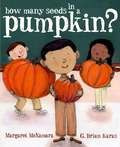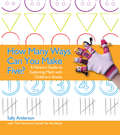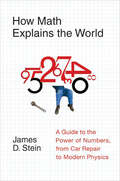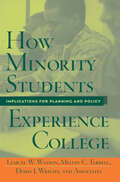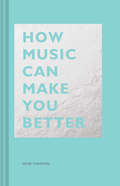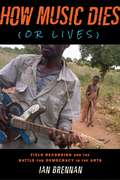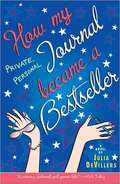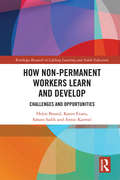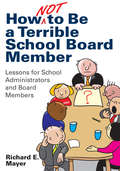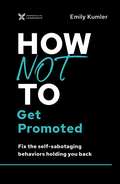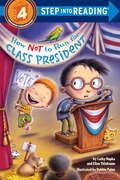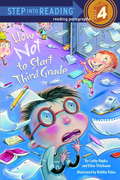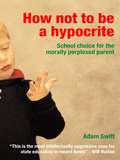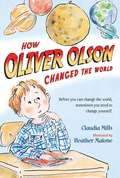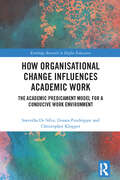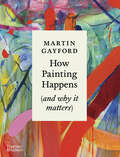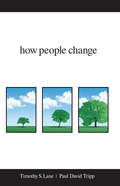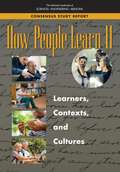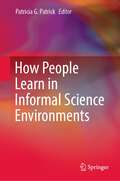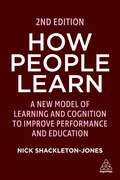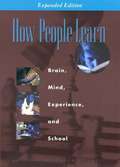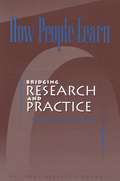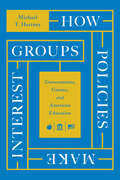- Table View
- List View
How Many Seeds in a Pumpkin?
by Margaret Mcnamara"How many seeds in a pumpkin?" Mr. Tiffin asks his class as they gather around the big, medium, and small pumpkins on his desk. Robert, the biggest kid, guesses that the largest one has a million seeds; Elinor, sounding like she knows what she's talking about, guesses the medium one has 500 seeds; and Anna, who likes even numbers better than odd ones, guesses that the little one has 22. Charlie, the smallest boy in the class, doesn't have a guess. Counting pumpkin seeds is messy business, but once the slimy job is done, to everyone's surprise, the smallest pumpkin has the most seeds! As Charlie happily exclaims, "Small things have a lot going on inside of them."
How Many Ways Can You Make Five?: A Parent's Guide to Exploring Math with Children's Books
by The Vermont Center for the Book Sally AndersonUse your child’s favorite books to explore and investigate the world of mathematics! In a world filled with patterns, shapes, sequences, and numbers – math is all around us. From an early age, children begin to notice and make connections between math concepts and everyday life, asking: How many? How high? How long? and How much does that weigh?Children’s books can bring math concepts to life. With the help of the stories and activities in How Many Ways Can You Make Five? you and your child will have a blast reading about, talking about, and exploring the world of math. Use favorite children’s books to investigate patterns and puzzles, learn how to subtract, and make maps.With four chapters that cover a multitude of themes, it’s never been easier to deepen your child’s understanding of important math and reading concepts at the same time!
How Math Explains the World: A Guide to the Power of Numbers, from Car Repair to Modern Physics
by James D. Stein&“Explores the application of math to problem solving in the everyday. . . . [W]ill appeal to both casual and serious fans of math or physics.&” —Publishers Weekly In How Math Explains the World, mathematician Stein reveals how seemingly arcane mathematical investigations and discoveries have led to bigger, more world-shaking insights into the nature of our world. In the four main sections of the book, Stein tells the stories of the mathematical thinkers who discerned some of the most fundamental aspects of our universe. From their successes and failures, delusions, and even duels, the trajectories of their innovations—and their impact on society—are traced in this fascinating narrative. Quantum mechanics, space-time, chaos theory and the workings of complex systems, and the impossibility of a &“perfect&” democracy are all here. Stein's book is both mind-bending and practical, as he explains the best way for a salesman to plan a trip, examines why any thought you could have is imbedded in the number p, and—perhaps most importantly—answers one of the modern world's toughest questions: why the garage can never get your car repaired on time. Friendly, entertaining, and fun, How Math Explains the World is the first book by one of California's most popular math teachers, a veteran of both &“math for poets&” and Princeton's Institute for Advanced Studies. And it's perfect for any reader wanting to know how math makes both science and the world tick.
How Minority Students Experience College: Implications for Planning and Policy
by Michael J. Cuyjet Fred A. Bonner II Melvin Cleveland Terrell Lemuel Watson Doris J. Wright"I feel like they act like they're so diverse and multicultural.This is not a representation of how it is for people who go here.""I know of several occasions, if it weren't for several faculty of color, I don't know how I would have made it from one day to the next." -- from student interviewsHave three decades of integration and multicultural initiatives in higher education delivered a better education to all students? Are majority and minority students reaping similar benefits, specifically in predominantly white colleges? Do we know what a multicultural campus should look like, and how to design one that is welcoming to all students and promotes a learning environment?Through a unique qualitative study involving seven colleges and universities considered national models of commitment to diversity, this book presents the views and voices of minority students on what has been achieved and what remains to be done. The direct quotations that form the core of this book give voice to Black, Hispanic, Asian, Native American and bi-racial students. They offer in their own words their perceptions of their campus cultures and practices, the tensions they encounter and what works for them.Rather than elaborating or recommending specific models or solutions, this book aims to provide insights that will enable the reader better to understand and articulate the issues that need to be addressed to achieve a well-adapted multicultural campus.Presidents, academic affairs professionals, student affairs personnel and faculty concerned with equity and diversity will find this book helpful and enlightening.
How Music Can Make You Better: (motivational Book, Neuroscience Book) (The HOW Series)
by Indre Viskontas PhDHow can certain songs carry us through a tough workout, comfort us after a breakup, or unite 50,000 diverse fans? In this fascinating field guide, neuroscientist and opera singer Indre Viskontas investigates what music is and how it can change us for the better—from deep in our neurons to across our entire society. Whether hip-hop fans, classically trained pianists, or vinyl collectors, readers will think about their favorite songs in a whole new way by the end of this book. This is a vibrant and smart gift for any audiophile.
How Music Dies (or Lives): Field Recording and the Battle for Democracy in the Arts
by Ian BrennanAll recordings document life, arising from a specific time and place, and if that place is artificial, the results will be as well. Culled from a lifetime of learning through failure and designed to provoke thought and inspiration for artists in every medium, How Music Dies (or Lives) is a virtual how-to manual for those on a quest for authenticity in an age of airbrushed and Auto-Tuned so-called "artists. ” Author and Grammy-winning producer Ian Brennan chronicles his own journeys to find new and ancient sounds, textured voices, and nonmalleable songs, and he presents readers with an intricate look at our technological society. His concise prose covers topics such as: *The damages of colonization in generalizing distinctive variations *The need for imperfection *The gaps between manufacturing and invention *The saturation of music in everyday life This guide serves those who ask themselves, "What’s wrong with our culture?” Along with possible answers are lessons in using the microphone as a telescope, hearing the earth as an echo, and appreciating the value of democratizing voices.
How My Private, Personal Journal Became a Bestseller
by Julia DevillersFormerly ordinary 14-year-old Jamie Bartlett is suddenly doing interviews and book signings, flying to L.A. to hang out with celebrities, and dating the hottest guy in school. Will all the attention go to her head?
How Non-Permanent Workers Learn and Develop: Challenges and Opportunities (Routledge Research in Lifelong Learning and Adult Education)
by Karen Evans Helen Bound Sahara Sadik Annie KarmelHow Non-Permanent Workers Learn and Develop is an empirically based exploration of the challenges and opportunities non-permanent workers face in accessing quality work, learning, developing occupational identities and striving for sustainable working lives. Based on a study of 100 non-permanent workers in Singapore, it offers a model to guide thinking about workers’ learning and development in terms of an ‘integrated practice’ of craft, entrepreneurial and personal learning-to-learn skills. The book considers how strategies for continuing education and training can better fit with the realities of non-permanent work. Through its use of case studies, the book exams the significance of non-permanent work and its rise as a global phenomenon. It considers the reality of being a non-permanent worker and reactions to learning opportunities for these individuals. The book draws these aspects together to present a conceptual frame of ‘integrated practices’, challenging educational institutions and training providers to design and deliver learning and the enacted curriculum not as separate pieces of a puzzle, but as an integrated whole. With conclusions that have wider salience for public policy responses to the rise of non-permanent work, this book will be of great interest to academics and researchers in the fields of adult education, educational policy and lifelong learning.
How Not to Be a Terrible School Board Member: Lessons for School Administrators and Board Members
by Richard E. MayerBuild a successful board by knowing where the land mines are Veteran school board member, Richard E. Mayer, takes a humorous approach to the serious relationship between school administrators and board members. While the overwhelming majority of school board members have good motives, even people who mean well can make bad moves. This book shows how to prevent good intentions from creating bad outcomes. Each chapter presents a negative behavior scenario and analysis, offers alternatives, and provides win-win solutions. Key features include: 28 brief case studies Lessons learned for board members Lessons learned for administrators
How Not to Get Promoted: Fix the Self-Sabotaging Behaviors Holding You Back (The How Not to Succeed Series)
by Emily KumlerYou work hard and turn in flawless reports, you stay late and kiss up to all the right people, and you still aren’t getting promoted. What gives? Well, you’re clearly screwing something up, and its time you find out what it is. It’s frustrating. You’re the first one in and the last one out. You’re working your butt off. But still, you have to watch other coworkers get promoted into shiny new titles, while you’re stuck in the same position you’ve been in for the last five years. Chances are it’s not about what you’re doing right--it’s about what you’re doing wrong. How Not to Get Promoted is filled with interviews and stories of people who were being held back by the things they didn't realize were working against them. The workplace is a minefield filled with politics and unspoken rules. This book is here to teach you: * How you’re screwing it up and what to do about it * How other people screwed it up before figuring it out * What you should stop doing immediately * What you should be doing more of Now, stop panicking and letting frustration hold you back. This book is the tool you need to get out of your career rut and make it to the next level!
How Not to Run for Class President
by Debbie Palen Ellen Vandenberg Catherine A. HapkaLooking for a fun, light introduction to the campaign process? Join the brothers from the How Not to . . . series as they navigate a class election! Third grader Will couldn't care less about boring school politics. But when his friend Chelsea proposes a Reading Buddy program that would require Will to hang out with the kindergartners (and therefore his little brother, Steve), he makes an impulsive decision to run against her! Supportive brother that he is, Steve takes full responsibility for managing his brother's campaign . . . and things quickly spiral out of control. This fun reader gently teaches what it means to be a responsible politician, and even gets some election basics into the mix. A hilarious tool to kick off classroom units on elections! Step 4 Readers use challenging vocabulary and short paragraphs to tell exciting stories. These books are for newly independent readers who read simple sentences with confidence.From the Trade Paperback edition.
How Not to Start Third Grade (Step into Reading)
by Cathy Hapka Debbie Palen Ellen TitlebaumWill should be excited to start third grade. But his little brother, Steve, is starting kindergarten. The same laugh-out-loud writing and hilarious illustrations that brought us How Not to Babysit Your Brother now portray the tribulations and embarrassments of starting school with a very troublesome little brother. School will never be the same!Cathy Hapka and Ellen Titlebaum are the authors of many books for children. This is their second book about Will and Steve. They live in Lincoln University, Pennsylvania, and New York City, respectively.Debbie Palen has illustrated many books for children, including How Not to Babysit Your Brother and the first four books in the Andrew Lost series. She lives in Cleveland, Ohio.
How Not to be a Hypocrite: School Choice for the Morally Perplexed Parent
by Adam SwiftHow not to be a hypocrite: the indispensable guide to school choice that morally perplexed parents have been waiting for.Many of us believe in social justice and equality of opportunity - but we also want the best for our kids. How can we square our political principles with our special concern for our own children? This marvellous book takes us through the moral minefield that is school choice today.Does a commitment to social justice mean you have to send your children to the local comprehensive - regardless of its academic results? Is it hypocritical to disapprove of private schools and yet send your child to one? Some parents feel guilty but shouldn't. Others should feel guilty but don't. Read How Not to be a Hypocrite, then answer the questionnaire, and work out where you stand on this crucial issue.
How Oliver Olson Changed the World
by Claudia MillsAfraid he will always be an outsider like ex-planet Pluto, nine-year-old Oliver finally shows his extremely overprotective parents that he is capable of doing great things without their help while his class is studying the solar system.
How Organisational Change Influences Academic Work: The Academic Predicament Model for a Conducive Work Environment (Routledge Research in Higher Education)
by Donna Pendergast Christopher Klopper Sureetha De SilvaHigher education institutions around the globe are facing complex issues that disrupt the usual roles and purposes of centres of learning and research. Forces such as globalisation, burgeoning knowledge-based economies, rapid adoption of new technology, and global competition are changing the work and lived experiences of academics across the globe. This book addresses the unprecedented effects of these global pressures, including the COVID-19 pandemic, on university work and the resulting opportunity for innovative disruption. It presents the voices of 16 Australian university academics, framed by standpoint theory, which provide a unique perspective and insights into the rapid shifts impacting universities and how these affect academics’ work lives. The stories uncover cases of disappointment and frustration, bullying and morale loss, alongside positive change and the awareness of the need to change expectations. This work informs the development of The Academic Predicament Model (APM), which points to the erosion of academic professionalism and identifies how such change in university work consequently de-professionalises academia in Australia. The long-term effect is to challenge the place and function of higher education institutions. The need for transformation, and potential for its outcomes, have never been greater, nor has the risk that the elements of the Academic Predicament Model will be amplified, causing the de-professionalising of academia to be further accelerated. This book will be of interest to researchers in higher education exploring neoliberalism and its impact on education and academics’ work.
How Painting Happens (and Why it Matters)
by Martin GayfordDrawing on decades of conversations with practicing artists, Martin Gayford offers intimate insight into the practice, meaning, and potential of painting. Painting is an almost inconceivably ancient activity that remains vigorously alive in the twenty-first century. Every successful painting creates a new world, which we inhabit for as long as we care to look at it. Paintings can incorporate profound ideas and paradoxes that can be grasped without words. For those who dedicate themselves to it, the art of painting can become an all-consuming, lifelong obsession. It is a subject on which painters themselves are often the most incisive commentators. Martin Gayford’s riveting and richly illustrated book deftly brings together numerous artists’ voices, past and present. It draws on a trove of conversations conducted over more than three decades with artists including Frank Auerbach, Gillian Ayres, Frank Bowling, Cecily Brown, Peter Doig, Lucian Freud, Katharina Fritsch, David Hockney, Claudette Johnson, R. B. Kitaj, Lee Ufan, Paula Rego, Gerhard Richter, Bridget Riley, Jenny Saville, Frank Stella, Luc Tuymans, Zeng Fanzhi, and many more. Here too is Vincent van Gogh on Rembrandt, John Constable on Titian, Francis Bacon on Velázquez, Lee Krasner on Pollock, and Jean-Michel Basquiat on Picasso. We hear the personal reflections of these artists on their chosen medium; how and why they paint; how they came to the practice; the influence of fellow painters; and how they find creative sustenance and inspiration in their art. How Painting Happens crosses the centuries to give us a wealth of insights into the endlessly compelling phenomenon of painters and painting.
How People Change: How Christ Changes Us By His Grace (Vantage Point Book Ser.)
by Paul David Tripp Timothy S. LaneA changed heart is the bright promise of the gospel.When the Bible talks about the gift of a new heart, it doesn't mean a heart that is immediately perfected, but a heart that is capable of being changed. Jesus' work on the cross targets our hearts, our core desires and motivations, and when our hearts change, our behavior changes. It's amazing to watch people who once seemed stuck in a pattern of words, choices, and behaviors start living in a new way as Christ changes their hearts.
How People Learn II: Learners, Contexts, And Cultures
by Engineering Medicine National Academies of SciencesThere are many reasons to be curious about the way people learn, and the past several decades have seen an explosion of research that has important implications for individual learning, schooling, workforce training, and policy. In 2000, How People Learn: Brain, Mind, Experience, and School: Expanded Edition was published and its influence has been wide and deep. The report summarized insights on the nature of learning in school-aged children; described principles for the design of effective learning environments; and provided examples of how that could be implemented in the classroom. Since then, researchers have continued to investigate the nature of learning and have generated new findings related to the neurological processes involved in learning, individual and cultural variability related to learning, and educational technologies. In addition to expanding scientific understanding of the mechanisms of learning and how the brain adapts throughout the lifespan, there have been important discoveries about influences on learning, particularly sociocultural factors and the structure of learning environments. How People Learn II: Learners, Contexts, and Cultures provides a much-needed update incorporating insights gained from this research over the past decade. The book expands on the foundation laid out in the 2000 report and takes an in-depth look at the constellation of influences that affect individual learning. How People Learn II will become an indispensable resource to understand learning throughout the lifespan for educators of students and adults.
How People Learn in Informal Science Environments?
by Patricia G. PatrickThis edited volume brings together an international perspective of 22 diverse learning theories applied to a range of informal science learning environments. The book is divided into 7 sections: community of practice, critical theory, identity theory, sociocultural, socioscientific, and social entrepreneurship, systems theory, and theory development. The chapters present how researchers from diverse backgrounds and cultures use theories in their work and how these may be applied as theoretical frameworks for future research. The chapters bridge theory and practice and collectively address a wide range of ages (children-adults) and contexts. The book is written to engage a broad audience of researchers in universities and museums, while appealing to the growing number of researchers and educators who recognize the importance of informal learning to the development of environmental and scientific literacy. It is essential reading for inexperienced researchers and those seeking new theoretical perspectives.
How People Learn: A New Model of Learning and Cognition to Improve Performance and Education
by Nick Shackleton-JonesHow can I design training so that it makes a real difference to employees' skills and development? This book gives L&D professionals everything they need to build effective learning experiences.How People Learn provides L&D professionals a new way of thinking about learning by exploring what happens when we learn. It shows how to apply insights from neuroscience, human behaviour and artificial intelligence (AI) to learning design including tips on how to interest, excite and engage staff in training. Using the author's '5Di model', this book demonstrates how to define, design and deploy training into existing workflows so it works both for and with employees. It also explores how simulations can be used to replicate a real-world challenge as closely as possible.The second edition features new material on learning in a hybrid world, and how to manage skills development and performance now that work, workplaces and workers have changed. It includes more practical guidance on building programmes with user-centred design and covers developments in the connection between learning and cognition, alongside case studies and examples from companies such as BP and the BBC.
How People Learn: Brain, Mind, Experience, and School
by National Research CouncilThis newly expanded edition shows how the theories and insights from the original book can translate into actions and practice. How People Learn provides answers to many questions -- when learning actually begins, how experts learn, and what teachers and schools can do to help children learn most effectively.
How People Learn: Bridging Research and Practice
by Committee on Learning Research Educational PracticeHow People Learn: Bridging Research and Practice provides a broad overview of research on learners and learning and on teachers and teaching. It expands on the 1999 National Research Council publication How People Learn: Brain, Mind, Experience, and School, Expanded Edition that analyzed the science of learning in infants, educators, experts, and more. In How People Learn: Bridging Research and Practice, the Committee on Learning Research and Educational Practice asks how the insights from research can be incorporated into classroom practice and suggests a research and development agenda that would inform and stimulate the required change. The committee identifies teachers, or classroom practitioners, as the key to change, while acknowledging that change at the classroom level is significantly impacted by overarching public policies. How People Learn: Bridging Research and Practice highlights three key findings about how students gain and retain knowledge and discusses the implications of these findings for teaching and teacher preparation. The highlighted principles of learning are applicable to teacher education and professional development programs as well as to K-12 education. The research-based messages found in this book are clear and directly relevant to classroom practice. It is a useful guide for teachers, administrators, researchers, curriculum specialists, and educational policy makers.
How Policies Make Interest Groups: Governments, Unions, and American Education
by Michael T. HartneyA critical, revelatory examination of teachers unions' rise and influence in American politics. As most American labor organizations struggle for survival and relevance in the twenty-first century, teachers unions appear to be an exception. Despite being all but nonexistent until the 1960s, these unions are maintaining members, assets—and political influence. As the COVID-19 epidemic has illustrated, today’s teachers unions are something greater than mere labor organizations: they are primary influencers of American education policy. How Policies Make Interest Groups examines the rise of these unions to their current place of influence in American politics. Michael Hartney details how state and local governments adopted a new system of labor relations that subsidized—and in turn, strengthened—the power of teachers unions as interest groups in American politics. In doing so, governments created a force in American politics: an entrenched, subsidized machine for membership recruitment, political fundraising, and electoral mobilization efforts that have informed elections and policymaking ever since. Backed by original quantitative research from across the American educational landscape, Hartney shows how American education policymaking and labor relations have combined to create some of the very voter blocs to which it currently answers. How Policies Make Interest Groups is trenchant, essential reading for anyone seeking to understand why some voices in American politics mean more than others.
How Policies Make Interest Groups: Governments, Unions, and American Education
by Michael T. HartneyA critical, revelatory examination of teachers unions' rise and influence in American politics. As most American labor organizations struggle for survival and relevance in the twenty-first century, teachers unions appear to be an exception. Despite being all but nonexistent until the 1960s, these unions are maintaining members, assets—and political influence. As the COVID-19 epidemic has illustrated, today’s teachers unions are something greater than mere labor organizations: they are primary influencers of American education policy. How Policies Make Interest Groups examines the rise of these unions to their current place of influence in American politics. Michael Hartney details how state and local governments adopted a new system of labor relations that subsidized—and in turn, strengthened—the power of teachers unions as interest groups in American politics. In doing so, governments created a force in American politics: an entrenched, subsidized machine for membership recruitment, political fundraising, and electoral mobilization efforts that have informed elections and policymaking ever since. Backed by original quantitative research from across the American educational landscape, Hartney shows how American education policymaking and labor relations have combined to create some of the very voter blocs to which it currently answers. How Policies Make Interest Groups is trenchant, essential reading for anyone seeking to understand why some voices in American politics mean more than others.
How Policies Make Interest Groups: Governments, Unions, and American Education
by Michael T. HartneyA critical, revelatory examination of teachers unions' rise and influence in American politics. As most American labor organizations struggle for survival and relevance in the twenty-first century, teachers unions appear to be an exception. Despite being all but nonexistent until the 1960s, these unions are maintaining members, assets—and political influence. As the COVID-19 epidemic has illustrated, today’s teachers unions are something greater than mere labor organizations: they are primary influencers of American education policy. How Policies Make Interest Groups examines the rise of these unions to their current place of influence in American politics. Michael Hartney details how state and local governments adopted a new system of labor relations that subsidized—and in turn, strengthened—the power of teachers unions as interest groups in American politics. In doing so, governments created a force in American politics: an entrenched, subsidized machine for membership recruitment, political fundraising, and electoral mobilization efforts that have informed elections and policymaking ever since. Backed by original quantitative research from across the American educational landscape, Hartney shows how American education policymaking and labor relations have combined to create some of the very voter blocs to which it currently answers. How Policies Make Interest Groups is trenchant, essential reading for anyone seeking to understand why some voices in American politics mean more than others.
